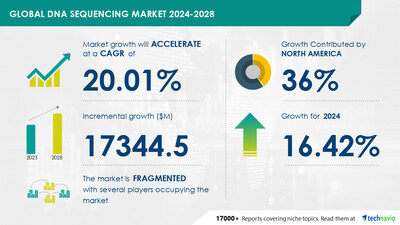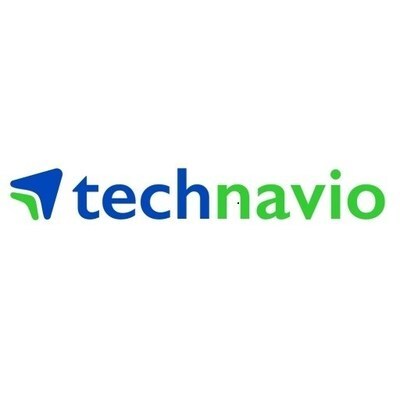NEW YORK, June 7, 2024 /PRNewswire/ — The global DNA sequencing market size is estimated to grow by USD 17.34 billion from 2024-2028, according to Technavio. The market is estimated to grow at a CAGR of over 20.01% during the forecast period. Growing adoption of ngs is driving market growth, with a trend towards emergence of third-generation sequencing methods. However, inadequate resources for dna sequencing in developing countries poses a challenge. Key market players include 10X Genomics Inc., Abbott Laboratories, Agilent Technologies Inc., Azenta Inc., Becton Dickinson and Co., BGI Genomics Co. Ltd., Bio Rad Laboratories Inc., Danaher Corp., Eurofins Scientific SE, F. Hoffmann La Roche Ltd., Illumina Inc., Laboratory Corp. of America Holdings, Macrogen Inc., Merck KGaA, Pacific Biosciences of California Inc., PerkinElmer Inc., QIAGEN NV, SeqLL Inc., Tecan Trading AG, and Thermo Fisher Scientific Inc..
Get a detailed analysis on regions, market segments, customer landscape, and companies – View the snapshot of this report
|
Forecast period |
2024-2028 |
|
Base Year |
2023 |
|
Historic Data |
2018 – 2022 |
|
Segment Covered |
End-user (Academic research, Clinical research, Hospitals and clinics, and Pharmaceutical and biotechnology companies), Solution (Products and Services), and Geography (North America, Europe, Asia, and Rest of World (ROW)) |
|
Region Covered |
North America, Europe, Asia, and Rest of World (ROW) |
|
Key companies profiled |
10X Genomics Inc., Abbott Laboratories, Agilent Technologies Inc., Azenta Inc., Becton Dickinson and Co., BGI Genomics Co. Ltd., Bio Rad Laboratories Inc., Danaher Corp., Eurofins Scientific SE, F. Hoffmann La Roche Ltd., Illumina Inc., Laboratory Corp. of America Holdings, Macrogen Inc., Merck KGaA, Pacific Biosciences of California Inc., PerkinElmer Inc., QIAGEN NV, SeqLL Inc., Tecan Trading AG, and Thermo Fisher Scientific Inc. |
Key Market Trends Fueling Growth
The DNA sequencing market is experiencing significant growth due to the emergence of third-generation sequencing technology. This advanced method reads DNA at the single-molecule level, eliminating the need for clonal amplification and preparative steps.
Third-generation sequencing offers long-reads, whole-transcript sequencing, and epigenetic modification detection. Challenges, such as accuracy issues, are being addressed through research and engineering solutions. Vendors are investing in third-generation sequencing R&D to expand their market presence and fuel market growth.
The DNA sequencing market is experiencing significant growth due to advancements in technology. Genetic research and biotechnology companies are investing heavily in this field. The use of next-generation sequencing techniques has made DNA sequencing faster and more cost-effective. These techniques include Illumina’s MiSeq and PacBio’s RS II. The demand for DNA sequencing is high in areas such as personalized medicine, agriculture, and environmental research.
The market is also driven by the increasing need for early disease detection and the development of new drugs. The use of bioinformatics tools and cloud computing has made data analysis more efficient. The market is expected to continue growing due to ongoing research and development efforts. Companies are focusing on improving the accuracy and speed of DNA sequencing to meet the demands of various industries.
Research report provides comprehensive data on impact of trend. For more details- Download a Sample Report
Market Challenges
• The DNA sequencing market has seen significant advancements, leading to increased accuracy and cost reduction. However, utilization remains low in developing countries due to factors such as high costs, lack of skilled personnel, and limited access to analysis tools. The high cost of sequencing instruments and analysis, as well as the lack of proper computational infrastructure, hinder market growth.
• Specialized training is necessary for DNA sequencing, but limited education capacities in developing countries pose a challenge. Outsourcing is essential due to the lack of facilities, but low-quality services increase costs and risks. Overall, resource limitations will significantly impact the growth of the DNA sequencing market in developing countries.
• The DNA sequencing market faces several challenges in delivering accurate and efficient results. These include the complexity of the genomic data, the need for large computational resources, and the high cost of sequencing technologies.
• Additionally, ensuring data security and privacy is a significant concern due to the sensitive nature of genetic information. Furthermore, the lack of standardization in data formats and analysis methods hampers interoperability and data sharing. Lastly, the rapid advancement of technology necessitates continuous innovation and adaptation to remain competitive.
For more insights on driver and challenges – Download a Sample Report
Segment Overview
- End-user
- 1.1 Academic research
- 1.2 Clinical research
- 1.3 Hospitals and clinics
- 1.4 Pharmaceutical and biotechnology companies
- Solution
- 2.1 Products
- 2.2 Services
- Geography
- 3.1 North America
- 3.2 Europe
- 3.3 Asia
- 3.4 Rest of World (ROW)
1.1 Academic research- The DNA sequencing market is experiencing significant growth due to increasing demand for genetic research and personalized medicine. Companies are investing in advanced technologies, such as next-generation sequencing, to improve efficiency and accuracy. This market is expected to continue expanding as more applications are discovered for DNA sequencing in various industries. Businesses are leveraging DNA sequencing to develop new products and services, leading to increased competition and innovation. Overall, the DNA sequencing market is a dynamic and promising sector for businesses seeking to advance scientific research and improve healthcare solutions.
For more information on market segmentation with geographical analysis including forecast (2024-2028) and historic data (2018 – 2022) – Download a Sample Report
Research Analysis
The DNA sequencing market is experiencing significant growth in the healthcare sector, driven by the adoption of precision medicine and the increasing importance of genetic variation in clinical diagnosis and drug discovery. Next-Generation Sequencing (NGS) technologies, including Whole-Genome Sequencing (WGS), have revolutionized the field of genomics, enabling the analysis of DNA variations at unprecedented speed and scale.
This genetic information is crucial for oncology, where it can inform clinical diagnosis and guide personalized treatment plans. Bioinformatics plays a vital role in interpreting the vast amounts of data generated by these sequencing platforms. The consumables segment, including sequencing chemicals and reagents, is a key driver of market growth. Applications of DNA sequencing extend beyond oncology to areas such as forensics, reproductive health, and biomarker discovery. Clinical diagnostic laboratories utilize benchtop sequencers for high-throughput analysis, enabling rapid and accurate diagnosis.
The DNA sequencing market encompasses technologies and techniques used to determine the order of nucleotides, or bases, in a DNA molecule. This information is crucial in various fields, including genetics, biotechnology, and pharmaceuticals. Technologies such as Sanger sequencing, next-generation sequencing (NGS), and single-molecule sequencing are driving innovation in this market. NGS technologies, in particular, have revolutionized the field by enabling high-throughput, cost-effective sequencing of large genomes.
Genomic research, diagnostics, and agricultural applications are significant end-users of DNA sequencing. Additionally, the growing interest in personalized medicine and gene therapy is expected to fuel market growth. The market is also witnessing advancements in technologies such as CRISPR-Cas9 gene editing and long-read sequencing, which offer improved accuracy and efficiency. Overall, the DNA sequencing market is a dynamic and evolving landscape, driven by technological advancements and growing applications in various industries.
Table of Contents:
1 Executive Summary
2 Market Landscape
3 Market Sizing
4 Historic Market Size
5 Five Forces Analysis
6 Market Segmentation
- End-user
- Academic Research
- Clinical Research
- Hospitals And Clinics
- Pharmaceutical And Biotechnology Companies
- Solution
- Products
- Services
- Geography
- North America
- Europe
- Asia
- Rest Of World (ROW)
7 Customer Landscape
8 Geographic Landscape
9 Drivers, Challenges, and Trends
10 Company Landscape
11 Company Analysis
12 Appendix
About Technavio
Technavio is a leading global technology research and advisory company. Their research and analysis focuses on emerging market trends and provides actionable insights to help businesses identify market opportunities and develop effective strategies to optimize their market positions.
With over 500 specialized analysts, Technavio’s report library consists of more than 17,000 reports and counting, covering 800 technologies, spanning across 50 countries. Their client base consists of enterprises of all sizes, including more than 100 Fortune 500 companies. This growing client base relies on Technavio’s comprehensive coverage, extensive research, and actionable market insights to identify opportunities in existing and potential markets and assess their competitive positions within changing market scenarios.
Contacts
Technavio Research
Jesse Maida
Media & Marketing Executive
US: +1 844 364 1100
UK: +44 203 893 3200
Email: media@technavio.com
Website: www.technavio.com/
![]() View original content to download multimedia:https://www.prnewswire.com/news-releases/dna-sequencing-market-size-is-set-to-grow-by-usd-17-34-billion-from-2024-2028–growing-adoption-of-ngs-to-boost-the-market-growth-technavio-302165939.html
View original content to download multimedia:https://www.prnewswire.com/news-releases/dna-sequencing-market-size-is-set-to-grow-by-usd-17-34-billion-from-2024-2028–growing-adoption-of-ngs-to-boost-the-market-growth-technavio-302165939.html
SOURCE Technavio

Featured image: Megapixl © Eraxion




